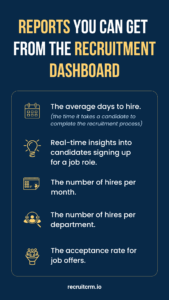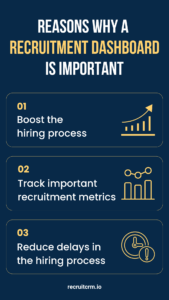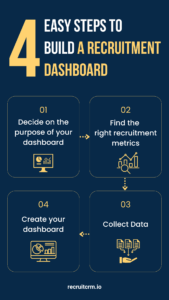Dive into this guide to understand how you can build and customize your recruitment dashboard—the best solution to manage your hiring data.
What is a recruitment dashboard?
A recruitment dashboard is a visual tool that gathers data from various sources, like enterprise HR software, performance management systems, and learning management systems, and presents it in one place for easy access and analysis.
Instead of checking multiple reports, you can view key performance indicators (KPIs) and recruitment metrics directly from the dashboard. It provides the most relevant data and can be customized to contain all the reports you need.

Also read: Recruitment data analytics for perfect candidate selection
3 reasons why you need a recruitment dashboard

1. Boost the hiring process
You need to analyze the recruitment data to determine what’s working in your current hiring process and which aspects need improvement. However, the vast amount of data makes it difficult to analyze it effectively.
Your dashboard provides insights into different aspects of the process. Using those insights, you can spot flaws in your approach and remove practices that damage it.
Let’s say that from your dashboard, you notice that while you’re spending a lot of resources on certain hiring channels, they aren’t pulling in recruits. In that case, you can just cut out underperforming channels and focus on successes.
2. Track important recruitment metrics
Recruitment metrics are the parameters used to measure the completion of your staffing goals and objectives. They are very helpful while tracking the progress of the hiring process. Unfortunately, they get sidelined or ignored easily due to other aspects of recruiting.
A recruitment dashboard puts metrics front and center, so they’re always in mind when making key decisions. Paying close attention to recruitment metrics can alter your strategies over time in line with trends.
3. Reduce delays in the hiring process
Before recruitment dashboards became popular, hiring teams had to rely on HR for insights, leading to delays that slowed the hiring process. They would have to wait for the response to requests and make decisions based on limited data in the meantime.
A recruitment analytic system provides a bird’s-eye view of data, allowing instant access to ensure that decision-making processes are always objective and data-driven.
This immediate access also helps streamline the staffing process and improve overall efficiency.
Also read: How to conduct a recruitment audit to streamline your hiring process?
How to build a recruitment dashboard?

Step 1: Decide on the purpose of your dashboard
Before you begin work on your dashboard, you need to know why you’re building one. What is its objective, and what information are you keen to collect?
Typically, dashboards are split into three types:
a. Analytical: These dashboards are all about insights. They dig deep into your recruitment data to help you spot trends. Recruitment analytics tools often contain lots of visualizations to help you better understand data.
b. Operational: These dashboards focus on recruitment’s day-to-day operations. They provide information on deadlines, the number of recruits gained each week, and other important operational insights.
c. Hybrid: As the name suggests, a hybrid dashboard is a combination of the best of both types. It’s handy for gaining an overview of the recruiting process.
Step 2: Find the right recruitment metrics
Once you have set objectives for the dashboard, you have to set metrics to add to it. These metrics are based on what aspects of your process you want to analyze. The metrics should be easily measurable and comparable to track progress effectively.
Consider some of the insights that help drive your recruitment forward. Some examples are listed below:
- How many staff left within a year of being employed?
- How long does it take to bring in new employees to your organization?
- How many applicants did you receive for a particular role?
- What is the percentage of people who accept vs. who reject job offerings?
These questions will help you to better determine a set of metrics. For example, to answer ‘How many staff left after a year of employment?’ you can use the ‘failed hires’ metric.
Step 3: Collect data
It goes without saying that your dashboard needs a steady flow of data to work efficiently. But it is not as easy as it sounds.
Your recruitment data isn’t stored in a single location. Data relating to recruitment will come from your applicant tracking system, whereas data relating to payment will come from your payroll software.
You must ensure that each data source properly feeds into your analytics tool. If a data source is incompatible, you’ll need an alternative way of transferring information, such as moving the data via a spreadsheet.
Step 4: Create your dashboard
With all your data in place and a clear set of metrics, it’s time to build your dashboard. You can view it as your blank canvas. When building it, keep the following factors in mind:
- Layout: The overall dashboard layout is essential for making data accessible. Consider how team members absorb information and the best layout for data storytelling.
- Visualizations: Consider which visuals will best represent your recruitment data. For example, to ensure diversity in the workplace, you can use a pie chart to visualize the ethnicity of applicants at a glance.
- Real-time data: The data you see on the dashboard should be up-to-date, i.e., it should show up as soon as it comes in. These cover different aspects of the recruitment process, ranging from job postings to interviews.
Also read: Data-driven recruitment: The complete guide for 2024 [+ 5 best practices]
3 best practices to follow while building a recruitment dashboard
So, now you have your recruitment dashboard, but is it giving you all the insights you need? If not, follow these tips to tailor it to your recruitment goals.
1. Pick the right tools
The data dashboarding tool you use will greatly influence its effectiveness. The right recruitment tools can provide you with all the features you need for an insightful dashboard.
It should include—
a. Access to intuitive reports to help recruiters get the insights they need.
b. Detailed visualizations, including the ability to visualize the candidate pipeline.
c. An overview of the recruitment operations.
2. Don’t overlook mobile recruitment
Phone hiring is becoming a more and more popular approach. In 2021, as many as 67% of job applications were done using mobile devices. To gain access to the broadest pool of candidates possible, your recruitment strategies must consider these applicants.
Be sure to include mobile-related metrics on your dashboard. For instance, the mobile traffic metric tells you how many mobile users are visiting your jobs page.
3. Try to keep it simple
When it comes to building a recruitment dashboard, simplicity is the key. It might sound counterintuitive; why not include as much data as you can? But remember, the point of a data management system is to provide quick access to important insights.
If you’re overloaded with data, it will be harder to process it. Ultimately, before adding any metrics or reports to your dashboard, ask, ‘Do they bring value?’ If they don’t, you don’t need to add them.
Also, recruiters won’t be the only ones to access your dashboard. Other parties, such as HR teams, managers, and directors, might also be interested in your data. Try to present information in a way that will be accessible to all stakeholders and that allows departments to exchange insights.
Also read: What is a mobile recruiting software? Here’s a comprehensive guide for you
Frequently asked questions:
1. What tools can I use to create a recruitment dashboard?
Depending on your needs and expertise, you can create a recruitment dashboard using various tools. Popular options include Microsoft Excel, Google Sheets, Tableau, and Power BI.
Additionally, some specialized HR software often comes with built-in dashboard capabilities tailored for recruitment needs, providing seamless integration with other HR functions.
2. How often should I update my recruitment dashboard?
It’s important to keep your recruitment dashboard updated to ensure accurate and current data for decision-making. Ideally, aim for real-time updates, especially if your tools and systems support it.
However, if real-time updates aren’t feasible, a weekly update interval is a good practice. Regular updates help you track ongoing trends, identify issues promptly, and make informed adjustments to your recruitment strategy.
3. How do I ensure data accuracy on my recruitment dashboard?
You can start by integrating your dashboard with trusted and consistent data sources. Also, regularly audit data entries to catch and correct any discrepancies and implement automated data validation processes to reduce human error and maintain data integrity.
These steps will help you maintain a high level of accuracy, ensuring that your recruitment decisions are based on the most precise and up-to-date information available.
Author bio:
Jesse Liszka is the Senior Communications Specialist at Paylocity, a leading provider of cloud-based payroll and human capital management software. With more than 12 years of experience in communications, client marketing, and content, she can be found on LinkedIn.




